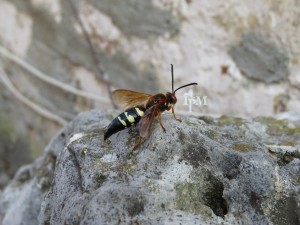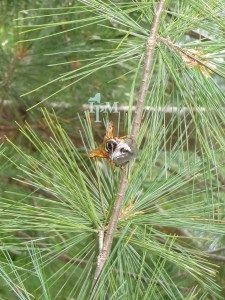Midsummer in New York is when things really start to heat up. And as if hot days aren’t enough, the sound of the dog day cicada makes it seem even hotter.
Cicadas are robust insects — up to 1 ¼ inch — with piercing mouthparts that suck up plant juices. Cicada nymphs live underground, feeding on sap from roots. Adults, on the other hand, feed from trees and shrubs.
But this story isn’t about dog day cicadas. It’s about the predator that eats them.

Cicada killer wasp measure from a little over an inch to 2 inches. And that’s big. Cicada killers are solitary wasps: each female digs her own burrow, usually in light or sandy soil. The males that guard a female can be aggressive — but as far as we’re concerned, it’s all an act. Why? They don’t have stingers. They pose little threat to humans — besides intimidation.
But females — they have stingers (though not for us). And that’s where the action begins. In fact, female cicada killers can catch cicadas in flight, then inject them with a paralyzing venom. Next, they drag them into their burrows — each female to her own — where the cicada serve as food for the wasp larvae as they grow.
For their own nourishment, though, these females dine on plant nectar. Just don’t provoke them too much — they can sting in self-defense.
Don’t want them too close to home? Just don’t use a wasp and hornet spray; learn why here. Putting down grass seed on exposed soil in sunny spots or mulching your flower beds will make the habitat less suitable for cicada killers.
